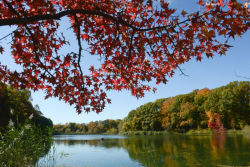Alley Pond Park
Oakland Lake
Located in the northeast corner of Queens between the neighborhoods of Bayside and Oakland Gardens, Oakland Lake is a 15,000-year-old spring-fed glacial kettle pond located in Alley Pond Park. The lake, once known as Mill Pond, became known as Oakland Lake, named for the 19th-century estate on this site called “The Oaks” for the many oak trees in the area.
The lake is fed by underground springs and a ravine, and at one time it was speculated that the lake was 600 feet deep and had a massive underground river leading to nearby Little Neck Bay. In 1969, a diving expedition went in search of the lake bottom, undergoing elaborate emergency prevention measures in case the alleged river’s current was too strong. However, the dive proved that the lake was only approximately 20 feet deep and did not lead to an underground river as legend claimed.
Oakland Lake was part of the estate of John Hicks, who first settled the land in 1645 as a recipient of one of the original Dutch land grants. In the 19th century, the lake was acquired by the Village of Flushing as a municipal water source and transferred to the City’s Department of Water Supply, Gas and Electricity after the consolidation of the five boroughs in 1898. A pumping station, called the Bayside Pumping Station, was built on the property. The water source was in use until the City began relying on upstate reservoirs and aqueducts after consolidation, although some local residents claimed that people drank from the lakeside springs as recently as the 1950s. Title to the lake was transferred to NYC Parks in 1934.
In the 1930s, Works Progress Administration (WPA) workers lined the brook that feeds Oakland Lake with cement and, later the brook and a small pond leading into the lake were filled. In 1941, officials from the Sanitation and Health Departments worked with WPA workers to fill in wetlands in an attempt to control the mosquito population. Three thousand men were put to work at nine Queens sites laying pipes, digging drainage ditches, and filling in and grading low areas, destroying the fragile marshland ecosystem.
As Queens grew, encroaching urbanization also threatened the lake. The construction of a nearby school and the Queensborough Community College and the widening of Springfield Boulevard on the lake’s western border contributed to its degradation. In 1969, 2,000 people participated in a “Walk in the Alley” led by Dr. John O. Riedl (1905–1992), a dean at Queensborough Community College who chaired the Alley Restoration Committee. The group, calling for the improvement of Oakland Lake, met with Parks Commissioner August Heckscher (1913–1997) and secured a commitment from NYC Parks to speed up plans to rehabilitate the lake. The John Reidl Wildflower Meadow in Alley Pond Park commemorates Reidl for his efforts on behalf of the preservation of the park.
Community pressure to protect the park remained steady through the 1970s and 80s. Gertrude Waldeyer (1908–1987), for whom the lake’s promenade was named in 1989, organized a grass-roots effort and founded the Oakland Lake and Ravine Conservation Committee to preserve the lake for future generations. In 1987, NYC Parks spent nearly $1 million to restore Oakland Lake to its natural state. In 1988, the New York State Department of Environmental Conservation designated the Oakland Lake area as freshwater wetlands, buttressing the Oakland Lake Committee’s efforts to protect the lake.
A capital improvement project to restore the 46-acre Oakland Lake Park was completed in 2011. The multi-phase restoration repaired the lake shoreline, ravines, and side slopes; planted of thousands of new trees; and installed storm sewers near the park to better control stormwater runoff, prevent erosion, and improve the water quality of the lake. The restoration also installed three paved fishing pads and canoe launches with boulder seating along the lake’s shoreline, providing the public with greater access to the water. The rescued and rehabilitated Oakland Lake is a perfect example what a neighborhood can do when it bands together to preserve the city’s precious natural environment.
Check out your park's Vital Signs
Clean & Safe
Green & Resilient
Empowered & Engaged Users
Share your feedback or learn more about how this park is part of a
Vital Park System










